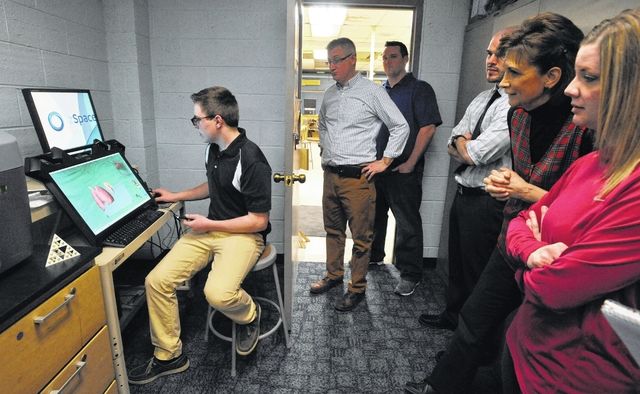Click here to subscribe today or Login.

WILKES-BARRE — In the basement of an 85-year old building in a room with lab tables discarded by another institution, Meyers High School ninth-grade student Kenny Macko talks about fractal antenna design — manufactured with a 3-D printer — that picks up more over-the air channels than some store-bought models.
Then he demonstrates a virtual reality program that lets you pull an image of a virus apart. Then he joins Kelsey Flores and Elsa Romero to demonstrate a project that would use a smart phone photo of a fingerprint to accurately identify a potential on-line voter.
The Wilkes-Barre Area School District STEM (Science, Technology, Engineering and Math) program may be barely a year old and running mostly on grants and ambition, but teachers feel they’ve got a lot to show, and Macko, Kelsey and Romero agreed to do that, coming in Thursday morning, on their day off, to show administrators from several schools what the program has taught them.
As Macko talked about the two new 3-D printers worth about $6,000 each and bought with grants, one was “printing” a small version of a wing designed by Leonardo daVinci for his “ornithopter,” a flying concept drawn some 400 years before the Wright Brothers.
Macko held up a three-sided pyramid comprised of four equilateral “Sierpinski” triangles — each with various sizes of more equilateral triangles cut into them. This, too, was a product of the 3-D printer. Wrap it with tinfoil and you’ve got a highly effective “fractal antenna.”
Next was the Z-scape machine, which looks like any other computer screen until you don the 3-D glasses with tiny sensors. Suddenly the screen image jumps out. Move your head around, and the view changes as it would with a real object. Point at it with a pen-like devise, and you can pull it apart, rotate it, and shine a “flashlight’ into darker recesses.
For now, Elias said, both printer and Z-scape are mostly using images downloaded from the web. There’s even a site dedicated to sharing user-created digital designs called, with appropriate omnipresence, “thingiverse.”
But the goal is to increasingly create original 3-D digital objects here in the school, teacher Keith Eberdts said, picking up a tiny boat propeller created with the printer. “We needed this for an engineering class, we made it.”
Elias said he also wants to create 3-D shapes on the Z-scape that would be use in geometry classes.
“It shouldn’t really be called STEM,” teacher Sean McLaughlin said. “It should be called Millennial instruction. It can be applied to every subject.” The STEM topics can permeate, but the real difference is the way it’s taught through “flipped classrooms.”
Broadly, that means students get the basic instruction on line, often at home. School becomes the place where the actual application of the lesson — traditionally the “homework” — is applied.
More precisely, it means students learn the subject by learning critical thinking and analytic prowess through collaborative projects. Flores demonstrated the point when she, Romero and Macko made a presentation about their on-line voting proposal. With the student who worked on the algorithm that would identify thumb scans absent, Flores stepped in and explained.
“How did you know all that information about the thumb prints?” Elias asked.
“Me?” Flores replied with a coquettish smile. “I pay attention.”





